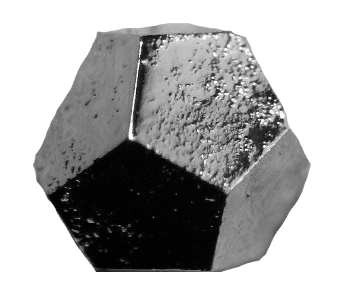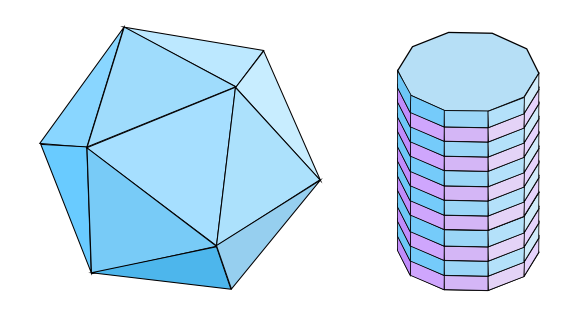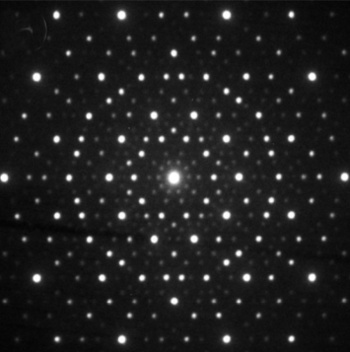Decagonal Quasicrystals
March 30, 2015
In an
earlier article (The 2011 Nobel Prize in Chemistry, October 7, 2011), I wrote about
Dan Shechtman and his award of the 2011 Nobel Prize in Chemistry for the discovery of
quasicrystals. Quasicrystals, like conventional crystal, exhibit
long-range order. Unlike the arrangement of atoms in conventional crystals, atoms in quasicrystals do not have
translational periodicity. Such a thing was considered impossible before Shechtman's 1984 publication of his discovery.[1-2]
Scientists are always cautious about breaking with their current
paradigm, so it took two years for Shechtman to get his discovery published. After all, everyone "knows" that five-fold symmetry is impossible in crystals, but his electron diffraction images showed an
icosahedral point group symmetry. Linus Pauling, who had shattered quite a few paradigms on his own, thought that crystallographic defects were responsible for such a result.
After this initial discovery, in the alloy,
Al0.82Mn0.14, other examples appeared, including naturally formed
icosahedrite, a mineral with composition Al
63Cu24Fe13. The icosahedrite specimen, found in the
Koryak Mountains in Russia, apparently came from a meteorite. The presumed source is a carbonaceous chondrite asteroid formed at the beginnings of the
Solar System.[3]

The edges of this quasicrystal of holmium, magnesium, and zinc, are about 2.2 millimeter long.
The crystal was grown from a flux by slowly cooling from 700-480 °C, and it shows clear pentagonal facets.
(Ames Laboratory, US Department of Energy, image, via Wikimedia Commons.)[4)]
Today, there's much
research performed on the
synthesis of quasicrystals, since quasicrystals formed from
metals are
non-metallic, and they are poor
electrical and thermal conductors. Quasicrystals are hard, their surfaces exhibit low
friction, and they don't oxidize. Unfortunately, quasicrystals are metastable, turning into ordinary crystals upon heating, so these unique properties are lost in practical application.
The
impact site of the Koryak meteorite has been searched for other types of natural quasicrystals, and an additional one has been found. This find, by the international team of scientists that discovered the first natural quasicrystal, included members from the
Universitá di Firenze (Florence, Italy),
Princeton University (Princeton, New Jersey),
Purdue University (West Lafayette, Indiana), the
Russian Academy of Sciences (Moscow, Russia), the
Massachusetts Institute of Technology (Cambridge, Massachusetts), Geoscience Technology (Houston, Texas), the
Smithsonian Institution (Washington, DC), and
Harvard University (Cambridge, Massachusetts).
This new natural quasicrystal has the composition Al
71Ni24Fe
5.[5] These elements are typically not found together, since
aluminum rapidly
oxidizes, removing the possibility of its alloying with
nickel and
iron.[6-7] This new quasicrystal was found amid grains of some other aluminum, nickel, and iron compositions,
steinhardtite (Al
38Ni
32Fe
30), iron-poor steinhardtite, (Al
50Ni
40Fe
10),
trevorite (NiFe
2O
4), and
taenite (FeNi).[5]

Left image, the five-fold crystal symmetry of the first natural quasicrystal, icosahedrite. Right, the ten-fold symmetry of the latest natural quasicrystal. (Illustration by the author using Inkscape, adapted from an illustration by Paul Steinhardt et al.)[7)]
The new quasicrystal exhibits ten-fold symmetry, and it has a crystal structure composed of flat, ten-sided disks stacked in a
column (see figure).[7] In
laboratory synthesis, this composition was stable over a narrow temperature range, at
standard pressure, from 1120
K to 1200 K (847-927 °C). This is consistent with the conclusion that the material in the Khatyrka asteroid reached temperatures of about 1100-1500 K, and it was then rapidly cooled during an impact-induced
shock while in
space.[5] Says
physicist, Princeton University
professor, and one of the study leaders,
Paul Steinhardt,
"We know there was a meteor impact, and that the temperature was around 1000 to 1200 degrees Kelvin, and that the pressure was a hundred thousand times greater than atmospheric pressure, but that is not enough to tell us all the details... We'd like to know whether the formation of quasicrystals is rare or is fairly frequent, how it occurs, and whether it could happen in other solar systems. What we find out could answer basic questions about the materials found in our universe."[6-7]

Selected area electron diffraction pattern demonstrating ten-fold symmetry of the quasicrystal.
(Fig. 4a of ref. 5, licensed under a Creative Commons Attribution 4.0 International License.)[5)]
Now that two natural quasicrystals have been found, there's a possibility that more will be forthcoming. Any new compositions found might lead to useful low friction and low thermal conductivity materials.[6-7] It would be interesting to see whether a
combinatorial chemistry approach could be developed for discovery of such quasicrystals. This research was funded in part by the
National Science Foundation.[5]
References:
- D. Shechtman, I. Blech, D. Gratias and J.W. Cahn, "Metallic phase with long range orientational order and no translation symmetry,", Physical Review Letters, vol. 53, no. 20 (November 12, 1984), pp. 1951-1953.
- Don Monroe, "Nobel Prize–Discovery of Quasicrystals, Phys. Rev. Focus, vol. 28, no. 14 (October 7, 2011), DOI: 10.1103/PhysRevFocus.28.14.
- Luca Bindi, John M. Eiler, Yunbin Guan, Lincoln S. Hollister, Glenn MacPherson Paul J. Steinhardt and Nan Yao, "Evidence for the extraterrestrial origin of a natural quasicrystal," Proc. Natl. Acad. Sci., vol. 109, no. 5 (January 5, 2012), pp. 1396-1401, doi: 10.1073/pnas.1111115109.
- I. R. Fisher, K. O. Cheon, A. F. Panchula, P. C. Canfield, M. Chernikov, H. R. Ott, and K. Dennis. "Magnetic and transport properties of single-grain R−Mg−Zn icosahedral quasicrystals [R=Y, (Y1−xGdx), (Y1−xTbx), Tb, Dy, Ho, and Er]," Phys. Rev., vol. B59, no. 1 (January 1, 1999), p. 308ff.
- Luca Bindi, Nan Yao, Chaney Lin, Lincoln S. Hollister, Christopher L. Andronicos, Vadim V. Distler, Michael P. Eddy, Alexander Kostin, Valery Kryachko, Glenn J. MacPherson, William M. Steinhardt, Marina Yudovskaya, and Paul J. Steinhardt, "Natural quasicrystal with decagonal symmetry," Scientific Reports, vol. 5, article no. 9111 (March 13, 2015), doi:10.1038/srep09111. This is an open access paper with a PDF file here.
- Catherine Zandonella, "Second natural quasicrystal found in ancient meteorite," Princeton University Research Blog, March 16, 2015.
- Second natural quasicrystal found in ancient meteorite, Princeton University Press Release, March 16, 2015.
Permanent Link to this article
Linked Keywords: Dan Shechtman; 2011 Nobel Prize in Chemistry; quasicrystal; conventional crystal; long-range order; atom; translational periodicity; academic publishing; scientist; paradigm; five-fold symmetry; electron diffraction; icosahedral symmetry; icosahedral point group symmetry; Linus Pauling; crystallographic defect; alloy; aluminium; Al; manganese; Mn; icosahedrite; copper; Cu; iron; Fe; Koryak Mountains; Russia; meteorite; carbonaceous chondrite; asteroid; Solar System; holmium; magnesium; zinc; millimeter; flux; Celsius; °C; pentagon; pentagonal; facet; Ames Laboratory; US Department of Energy; Wikimedia Commons; research; chemical synthesis; metal; non-metal; electrical conductor; thermal conductivity; thermal conductor; hardness; hard; surface; friction; oxide; oxidize; metastability; metastable; heat; heating; impact event; impact site; Universitá di Firenze (Florence, Italy); Princeton University (Princeton, New Jersey); Purdue University (West Lafayette, Indiana); Russian Academy of Sciences (Moscow, Russia); Massachusetts Institute of Technology (Cambridge, Massachusetts); Smithsonian Institution (Washington, DC); Harvard University (Cambridge, Massachusetts); nickel; Ni; aluminum; nickel; iron; steinhardtite; trevorite; taenite; Inkscape; column; laboratory; standard pressure; Kelvin; K; shock wave; outer space; physicist; professor; Paul Steinhardt; pressure; atmospheric pressure; universe; electron diffraction pattern; Creative Commons Attribution 4.0 International License; combinatorial chemistry; National Science Foundation.